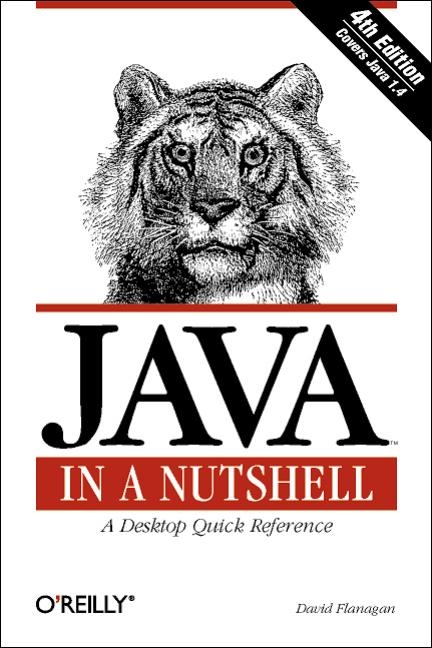
Java in a Nutshell
O'Reilly Media (Verlag)
978-0-596-00283-1 (ISBN)
- Titel ist leider vergriffen;
keine Neuauflage - Artikel merken
Java keeps growing, adding features, functionality, complexity, and tempting developers to growl with frustration. The 1.4 release of Java 2 Standard edition increases the size of the platform by 50%, to 2757 classes in 135 packages. This guide to the 1.4 version of Java contains an accelerated introduction to the Java programming language and its key APIs so programmers can start writing code right a way. It covers the new features that come with version 1.4 which include: high-performance NIO API; support for pattern matching with regular expressions; a logging API; a user preferences API; new collections classes; an XML-based persistence mechanism for Java Beans; support for XML parsing using both the DOM and SAX APIs; user authentication with the JAAS API; support for secure network connections using the SSL protocol; and support for cryptography. The book contains O'Reilly's quick-reference for all the classes in the essential Java packages, so users can dive in and find what is needed to make the 1.4 version work for them.
David Flanagan is a computer programmer who spends most of his time writing about JavaScript and Java. His books with O'Reilly include Java in a Nutshell, Java Examples in a Nutshell, Java Foundation Classes in a Nutshell, JavaScript: The Definitive Guide, and JavaScript Pocket Reference. David has a degree in computer science and engineering from the Massachusetts Institute of Technology. He lives with his wife and son in the U.S. Pacific Northwest bewteen the cities of Seattle, Washington and Vancouver, British Columbia. David has a simple website at http://www.davidflanagan.com.
Preface; PART 1: Introducing Java; Chapter 1. Introduction What Is Java? Key Benefits of Java An Example Program; Chapter 2. Java Syntax from the Ground Up The Unicode Character Set Comments Identifiers and Reserved Words Primitive Data Types Expressions and Operators Statements Methods Classes and Objects Array Types Reference Types Packages and the Java Namespace Java File Structure Defining and Running Java Programs Differences Between C and Java; Chapter 3. Object-Oriented Programming in Java The Members of a Class Creating and Initializing Objects Destroying and Finalizing Objects Subclasses and Inheritance Data Hiding and Encapsulation Abstract Classes and Methods Interfaces Inner Class Overview Static Member Classes Member Classes Local Classes Anonymous Classes How Inner Classes Work Modifier Summary C++ Features Not Found in Java; Chapter 4. The Java Platform Java Platform Overview Strings and Characters Numbers and Math Dates and Times Arrays Collections Types, Reflection, and Dynamic Loading Threads Files and Directories Input and Output Streams Networking Properties and Preferences Logging The New I/O API XML Processes Security Cryptography; Chapter 5. Java Security Security Risks Java VM Security and Class File Verification Authentication and Cryptography Access Control Security for Everyone Permission Classes; Chapter 6. JavaBeans Bean Basics JavaBeans Conventions Bean Contexts and Services; Chapter 7. Java Programming and Documentation Conventions Naming and Capitalization Conventions Portability Conventions and Pure Java Rules Java Documentation Comments; Chapter 8. Java Development Tools appletviewer extcheck jar jarsigner java javac javadoc javah javap jdb keytool native2ascii policytool serialver; PART 2: API Quick Reference How to Use This Quick Reference Finding a Quick-Reference Entry Reading a Quick-Reference Entry; Chapter 9. java.beans and java.beans.beancontext; Chapter 10. java.io; Chapter 11. java.lang, java.lang.ref, and java.lang.reflect; Chapter 12. java.math; Chapter 13. java.net; Chapter 14. java.nio and Subpackages; Chapter 15. java.security and Subpackages; Chapter 16. java.text; Chapter 17. java.util and Subpackages; Chapter 18. javax.crypto and Subpackages; Chapter 19. javax.net and javax.net.ssl; Chapter 20. javax.security.auth and Subpackages; Chapter 21. javax.xml.parsers, java.xml.transform, and Subpackages; Chapter 22. org.ietf.jgss; Chapter 23. org.w3c.dom; Chapter 24. org.xml.sax, org.xml.sax.ext, and org.xml.sax.helpers; Chapter 25. Class, Method, and Field Index; Index
| Erscheint lt. Verlag | 23.4.2002 |
|---|---|
| Zusatzinfo | illustrations, index |
| Verlagsort | Sebastopol |
| Sprache | englisch |
| Maße | 152 x 229 mm |
| Gewicht | 1158 g |
| Einbandart | kartoniert |
| Themenwelt | Informatik ► Programmiersprachen / -werkzeuge ► Java |
| Mathematik / Informatik ► Informatik ► Web / Internet | |
| ISBN-10 | 0-596-00283-1 / 0596002831 |
| ISBN-13 | 978-0-596-00283-1 / 9780596002831 |
| Zustand | Neuware |
| Haben Sie eine Frage zum Produkt? |
aus dem Bereich


